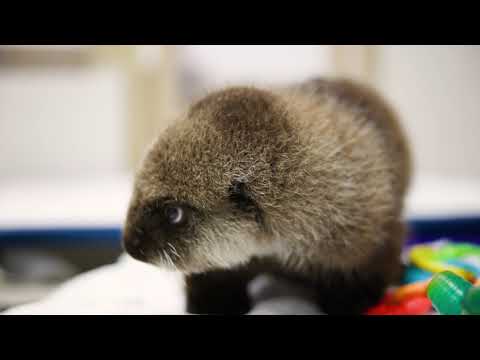– Delightful Habits: Unveiling the playful demeanor of Northern Sea Otter pups with their chilling pastime.
– Hydration Through Cuisine: Exploring how Sea Otters acquire their moisture needs directly from their diet, bypassing the necessity of ice and water as a drink.
– Interaction and Stimulation: The hidden reasons behind Sea Otters’ fascination with ice as a tool for engagement and development.
Tucked away in the northern Pacific Ocean’s sinuous waterways and coastal alcoves, the Northern Sea Otter holds court as one of the world’s most captivating mammals. Amidst the tumbling waves and kelp forest kingdoms, a furry and whiskered phenomenon kindles the imagination of wildlife enthusiasts and casual observers alike. For the Northern Sea Otter pup, a bundle of energy and endearing charm embarks on a curious arctic banquet ritual in those briny depths and frigid playfields. Here, amid a realm that is both unforgiving and nurturing, the otter pup engages in a pastime that is as delightful as it is unique: munching on ice.
Now, the sight of an otter pup playfully gnawing on a shard of ice might elicit chuckles and awe, but it opens a porthole into the inner workings of these marine denizens. While commonplace to the human eye, ice plays no usual role in the otter’s quest for sustenance. Yet, you’ll find these innovative creatures incorporating it into their routine with gusto. To the otter, particularly the juvenile, ice is akin to a plaything—a tactile and auditory sensation that provides a crunchy bite and an interactive experience.
Let’s unwrap the layers behind this icy indulgence and see what truly lies beneath the surface. Interestingly, otters are creatures designed with dietary efficiency in mind. Every morsel of food they consume—from the slippery eel to the calciferous crab—is meticulously calculated to fuel their vigorous lifestyle in the cold oceanic environment. This is a world where every calorie counts, and each meal is a carefully procured treasure. Contrary to what might be expected, their hydration does not come from lazily sipping on freshwater streams or lapping up seawater.
The key to the otter’s water needs lies in their prey. The fish, invertebrates, and the occasional crustaceans they expertly capture provide not just a medley of proteins and fats but transport water locked within the very cells of their quarry. Thus, with a professional pickpocket’s grace, the Sea Otter extracts its life-sustaining elements from these aquatic offerings, mitigating the need to drink in the human sense of the word.
Yet, here we are, gentling bobbing on the undulating narrative where our fluffy protagonist exhibits an all-too-human trait: play. For sea otters, particularly the playful pups, ice is more than a substance; it is a toy, a novelty to explore with all senses. Keen observers might note pups batting at floating ice like kittens with a ball of yarn, twirling it with dexterous paws that could shame the most seasoned magicians. This playful interaction is no frivolous event—it’s integral to the otter’s development.
Consider the young otter’s environment—an ever-changing, three-dimensional landscape that demands a sharp wit and an adaptive mindset. Through play, pups practice the skills they need to survive and thrive in their aquatic realm. Handling ice helps them refine their paw agility and coordination, skills crucial for feeding upon less frigid items in their underwater smorgasbord. It is early education, where the classroom is the boundless ocean and the curriculum is coded in instinct.
Moreover, this enchanting exchange between otters and ice reveals their social structures. Sea otters are known to be gregarious, with dynamics and bonds that can be as complex as any terrestrial pack or tribe. In its genuine pursuit, the ice-munching pup is willing to engage, to explore—to fit into an ever-shifting mosaic of otters that will define its social landscape.
Yet, what stands out most is the sheer glee that radiates from these furry creatures as they conquer their gelid treats. Watch an otter’s eyes widen as it crunches down on an icy morsel, embodying the sheer joy found in the simplest of acts—even when they serve no apparent nutritional value. Look closer, and you witness a lesson unspoken but profoundly resonant: find joy where you can, even in the frozen fragments of your world.
Intriguingly, when an otter clutches a fragment of ice, it’s communing with its ancestors. Historically, these otters have grappled with the elements, withstanding icy waters and the changing tides of climate and human influence. The ice is not just a plaything but a symbol—a harbinger of the otter’s evolutionary journey through epochs where ice dominated the narrative.
As autumnal frosts encroach upon the summer seas, you’ll find the otter pup still frolicking; ice clutched in paw, a visage of jubilation painted across a canvas of dusky fur and sprawling kelp. The otter’s crunching delight does not wane with the changing seasons; it follows the pup from its earliest days until it becomes a wizened member of the otter realm.
Such scenes unfurl against a tapestry of human fascination with nature’s minutiae, where every creature’s peculiarities contribute to an intricate mosaic of life. Observing this ice-eating ritual is to partake in the simplicity and complexity of nature’s handiwork—a chance to witness the toil, joy, and friendliness of a creature perfectly adapted to its maritime domain.
*****
Source Description
Watch as the pup munches on a crunchy, icy treat. Ice is more of an interactive treat for the sea otters rather than a source of hydration because they get all the water they need from their food.

